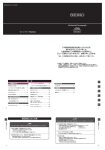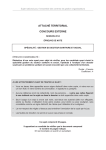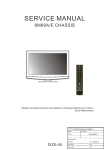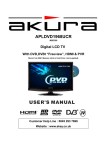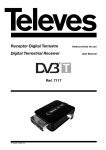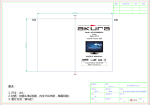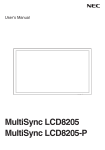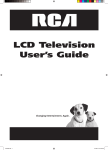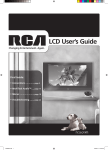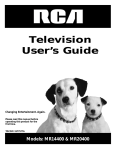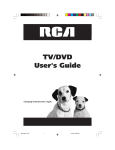Download Skyworth SLTV-32L29A-2 User's Manual
Transcript
SLTV-32L29A-2
Description:
SIZE:A5
MANUAL-8R28
MODEL.
32L29
JOB NO.
95054U
Brand Name:
SKYWORTH
Engineering Dept:
Artwork By:
Date:
Checked By:
Date:
Approved By:
Date:
2009-05-20
The lighting flash with arrow head within a
triangle is intended to tell the user that parts
inside the product are a risk of electric shock
to persons.
WARNING
RISK OF ELECTRIC SHOCK
DO NOT OPEN
WARNING: TO REDUCE THE RISK OF ELECTRIC SHOCK DO NOT
REMOVE COVER OR BACK. NO USER-SERVICEABLE PARTS INSIDE.
REFER SERVICING TO QUALIFIED SERVICE PERSONNEL.
Double insulation this is class
The exclamation point within a triangle is
intended to tell the user that important
operating and servicing instructions are in
the papers with the appliance.
apparatus.
The mains plug used as the disconnect device. The disconnect device shall remain readily operable.
WARNING: To reduce the risk of electric shock do not expose this apparatus to rain or moisture and objects
filled with liquids, such as vases, should not be placed on this apparatus.
WARNING: According to the industrial standards, there are a certain number of defective pixels both bright
and dark that are acceptable. Although we produce panel with more than 99.99 percent active
cells, there still may be some cells that do not produce light or remain lit. For more information,
please contact sales or the technical support.
WARNING: Do not leave any stationary images, patterns, PIP box, or letterbox images on the screen for an extended
period of time. Also, do not display the same stationary patterns frequently. This may result in permanent
ghost images on the display unit. This type of damage is not covered under warranty. Examples of this
type of situation can be but not limited to the following: side bar images, stock market report bars, video
game patterns, closed captioning, shopping channel logo, price display, and letterbox black bars. To
prevent this type of damage, display constant moving images that fill the screen as often as possible.
CAUTION
Changes or modifications not expressly approved by the party responsible for compliance with the FCC
,
Rules could void the use s authority to operate this equipment.
TV/CATV MODE SELECTION
When shipped from the factory, the TV/CATV menu option is set to the "TV" mode. If using CATV, set the
menu option to "CATV" (Cable Television)
IMPORTANT SAFETY INSTRUCTIONS
PORTABLE CART WARNING
1.READ INSTRUCTIONS - All the safety and operating
instructions should be read before the unit is operated.
2.RETAIN INSTRUCTIONS - The safety and operating
instructions should be retained for future reference.
3.HEED WARNINGS - All warnings on the unit and in
the operating instructions should be adhered to.
4.FOLLOW INSTRUCTIONS - All operating and use
instructions should be followed.
5.CLEANING - Unplug this unit from the wall outlet
before cleaning. Do not use liquid cleaners or aerosol
cleaners. Use a damp cloth for cleaning the exterior
cabinet only.
6.ATTACHMENTS - The manufacturer of this unit does
not make any recommendations for attachments, as
they may cause hazards.
7.WATER AND MOISTURE - Do not use this unit near
water. For example, near a bathtub, washbowl, kitchen
sink, laundry tub, in a wet basement, or near a
swimming pool.
8.ACCESSORIES - Do not place this unit on an
unstable cart, stand, tripod, bracket, or table.
The unit may fall, causing serious injury, and serious
damage to the unit. An appliance and cart combination
should be moved with care. Quick stops, excessive
force, and uneven surfaces may cause the appliance
and cart combination to overturn.
S3126A
9.VENTILATION - Slots and openings in the cabinet
back or bottom are provided for ventilation, to ensure
reliable operation of the unit and to protect it from
overheating. These openings should never be
blocked by placing the unit on a bed, sofa, rug, or
other similar surface. This unit should never be
placed near or over a radiator or heat source. This
unit should not be placed in a built-in installation,
such as a bookcase, or rack unless proper ventilation
is provided or the manufacture's instructions have
been adhered to.
10.POWER SOURCE - This unit should be operated
only from the type of power source indicated on the
rating plate. If you are not sure of the type of power
supply to your home, consult your appliance dealer
or local power company. For units intended to
operate from battery power, or other sources, refer to
the operating instructions.
-1-
11.POLARIZATION - This unit is equipped with a
polarized alternating current line plug (a plug
having one blade wider than the other). This plug
will fit into the power outlet only one way. This is a
safety feature. If you are unable to insert the plug
fully into the outlet, try reversing the plug. If the
plug still fails to fit, contact your electrician to
replace your obsolete outlet. Do not defeat the
safety purpose of the polarized plug.
12.POWER-CORD PROTECTION - Power supply
cords should be routed so that they are not likely
to be walked on or pinched by items placed upon
or against them, paying particular attention to
cords at plugs, convenience receptacles, and the
point where they exit from the appliance.
13.LIGHTNING - To protect your unit during a
lightning storm, or when it is left unattended and
unused for long periods of time, unplug it from the
wall outlet and disconnect the antenna or cable
system. This will prevent damage to the unit due
to lightning and power line surges.
14. POWER LINES - An outside antenna system
should not be located in the vicinity of overhead
power lines, or other electric light or power
circuits, or where it can fall into such power lines
or circuits. When installing an outside antenna
system, extreme care should be taken to keep
from touching such power lines or circuits as
contact with them might be fatal.
15.OVERLOADING - Do not overload wall outlets
and extension cords as this can result in a risk of
fire or electric shock.
16.OBJECT AND LIQUID ENTRY - Do not push
objects through any openings in this unit as they
may touch dangerous voltage points or short out
parts that could result in fire or electric shock.
Never spill or spray any type of liquid into the unit.
17.OUTDOOR ANTENNA GROUNDING - If an
outside antenna or cable system is connected to
the unit, be sure the antenna or cable system is
grounded to provide some protection against
voltage surges and built-up static charges.
Section 810 of the National Electrical Code,
ANSI/NFPA 70, provides information with respect
to proper grounding of the mast and supporting
structure, grounding of the lead-in wire to an
antenna discharge unit, size of grounding
conductors, location of antenna discharge unit,
connection to grounding electrodes, and
requirements for the grounding electrode.
18.SERVICING - Do not attempt to service this
unit yourself as opening or removing covers may
expose you to dangerous voltage or other
hazards. Refer all servicing to qualified service
personnel.
19.DAMAGE REQUIRING SERVICE - Unplug this
unit from the wall outlet and refer servicing to
qualified service personnel under the following
conditions:
A. When the power-supply cord or plug is
damaged.
B. If liquid has been spilled, or objects have
fallen into the unit.
C. If the unit has been exposed to rain or water.
D. If the unit does not operate normally by
following the operating instructions. Adjust
only those controls that are covered by the
operating instructions, as an improper
adjustment of other controls may result in
damage and will often require extensive
work by a qualified technician to restore the
unit to Its normal operation.
E. If the unit has been dropped or the cabinet
has been damaged.
F. When the unit exhibits a distinct change in
performance, this indicates a need for service.
20.REPLACEMENT PARTS - When replacement
parts are required, be sure the service technician
uses replacement parts specified by the
manufacturer or those that have the same
characteristics as the original part. Unauthorized
substitutions may result in fire, electric shock or
other hazards.
21.SAFETY CHECK - Upon completion of any
service or repairs to this unit, ask the service
technician to perform safety checks to determine
that the unit is in proper operating condition.
22.HEAT - The product should be situated away
from heat sources such as radiators, heat
registers, stoves, or other products(including
amplifiers) that produce heat.
23.NOTE TO CATV SYSTEM INSTALLER - This
reminder is provided to call the CATV system
installer s attention to Article 820-40 of the NEC
that provides guidelines for proper grounding and,
,
In particular,
specifies that the cable ground shall
be connected to the grounding system of the
building, as close to the point of cable entry as
practical.
EXAMPLE OF ANTENNA GROUNDING AS PER
NATIONAL ELECTRICAL CODE S2898A
ANTENNA LEAD
IN WIRE
GROUND
CLAMP
ELECTRIC
SERVICE
EQUIPMENT
ANTENNA DISCHARGE UNIT
(NEC SECTION 810-20)
GROUNDING CONDUCTORS
(NEC SECTION 810-21)
GROUND CLAMPS
NEC - NATIONAL ELECTRIC CODE
-2-
POWER SERVICE GROUNDING
ELECTRODE SYSTEM
(NEC ART 250. PART H)
Table of Contens
Important Safety Instructions
Connections & Setup
Preparation..............................................................................................5
Preparing Your LCD TV For Wall Mounting..................................................5
To Remove The Stand Base....................................................................... 5
Things to Consider Before You Connect ..................................................6
Protect Against Power Surges ................................................................... 6
Instructions at the beginning of the User's Guide ......................................... 6
Position Cables Properly to Avoid Audio Interference ...................................6
Use Indirect Light ..................................................................................... 6
Get the Picture .................................................................................... 6-7
Getting Channels ..................................................................................... 7
Choose Your Connection ....................................................................7-11
Video (Basic) Connection .......................................................................... 8
Component Video (Advanced) Connection .................................................. 8
HDMI/DVI Connection ............................................................................. 10
PC Connection ........................................................................................ 11
Plug in the TV ........................................................................................ 12
Put Batteries in the Remote ................................................................... 12
Turn on the TV ....................................................................................... 12
How to Use the Remote Control to Complete the Initial Setup .................12
Complete the Initial Setup ..................................................................... 12
Set the Menu Language ...........................................................................12
Complete Channel Setup .........................................................................12
What To Expect ......................................................................................13
Watching TV ...........................................................................................13
Changing Channels ................................................................................ 13
Explanation of Jacks (in alphabetical order) ..........................................13
Buttons and Other Jacks On Your TV ..................................................... 14
Side Panel Buttons ..................................................................................14
Using the Remote Control
Using the Remote Control
The Buttons on the Remote Control ..................................................15-16
Using the Menu System
Using the Menu System ......................................................................... 17
Picture Menu .....................................................................................17-18
Sound Menu ...........................................................................................19
Channel Menu ...................................................................................19-21
Channel Banner ...................................................................................... 21
Setup Menu ...................................................................................... 22-23
-3-
Table of Contens
Parental Controls
Parental Controls and V-Chip .................................................................24
How V-Chip Works for USA and Canada .....................................................24
Lock Parental Controls............................................................................. 24
The V-Chip Ratings screen........................................................................24
US V-Chip TV Ratings ..............................................................................24
Blocking specific content themes .............................................................. 25
V-Chip USA Movie Rating Limit ................................................................. 26
Blocking Canadian V-Chip Ratings ........................................................... 26
Block Channel ......................................................................................... 26
Button Block ............................................................................................27
Change Password ....................................................................................27
Other Information
Frequently Asked Questions (FAQs) .......................................................28
Care and Cleaning ..................................................................................28
Troubleshooting ................................................................................29-31
TV Problems............................................................................................29
Problems with HDMI connection................................................................ 30
The remote control dones t work.................................................................31
Problems with V-Chip/Parental controls ..................................................... 31
What else can I do?...................................................................................31
V-Chip Rating Explanations ...............................................................32-33
US V-Chip Rating System .........................................................................32
Canadian English V-Chip Rating System ....................................................32
Canadian French V-Chip Rating System .................................................... 33
Main Technical Specifications ................................................................34
Warranty Card..................... .............................................................. 35-36
-4-
Preparation
Preparation
Thank you very much for your purchase of this product-the most natural Colour Television Receiver.
To enjoy your set to the full from the very beginning, read this manual carefully and keep it handy
for ready reference.
The power consumption of the display is approximately 150 watts, please use the power cord
designated for the product. When an extension cord is required, use one with the correct power
rating. The cord must be grounded and the grounding feature must not be defeated.
The product should be installed on a flat surface to avoid tipping. Space should be maintained
between the back of the product and the wall for proper ventilation. If you would like to mount the
TV to the wall, please see " Preparing the LCD for Wall Mounting" below for additional information.
Avoid installing the product in the kitchen, bathroom or other places with high humidity, dust or
smoke so as to shorten the service life of the electronic components.
Please ensure the product is installed with the screen in landscape orientation. Any 900 clockwise
or counterclockwise installation may induce poor ventilation and excessive component damage.
Preparing Your LCD TV For Wall Mounting
The HDTV can either be kept on the stand base or mounted to the wall for viewing. If you choose to
mount the HDTV to the wall, please follow the instructions below .
To Remove The Stand Base:
1.Unplug all the cables and cords from your LCD TV.
2.Place the LCD TV face down on a soft and flat surface (blanket,
foam, cloth, etc) to prevent any damage to the display.
3.Remove the screws on the back panel of the TV located near
the bottom so that the base stand can be removed. (See the right
figure)
4.Gently pull the stand away from the display by grasping firmly
to the base.
5.Now the display can fit securely to a mount (sold separately) by
utilizing the mounting holes in the back panel of the display (See
the right figure). Please make sure to read the directions of your
specific wall mount to properly hang the HDTV. Make sure the
wall mount is rated to support at least 65 lbs.
Professional mounting kits and installation service are
recommended.
-5-
Connections and Setup
Connections and Setup
Things to Consider Before You Connect
Protect Against Power Surges
Connect all devices before you plug any of their power cords into the wall outlet or power
strip. NEVER plug your TV into an outlet that is controlled by a wall switch.
Turn off the TV and/or device(s) before you connect or disconnect any cables.
Make sure all antennas and cables are properly grounded. Refer to the Important Safety
Instructions at the beginning of the User's Guide
Protect Devices from Overheating.
Don't block ventilation holes on any of the devices. Arrange the devices so that air can
circulate freely.
Don't stack devices.
If you place devices in a stand, make sure you allow adequate ventilation.
If you connect an audio receiver or amplifier, place it on the top shelf so the heated air
from it won't flow around other devices.
Position Cables Properly to Avoid Audio Interference
Insert each cable firmly into the designated jack.
If you place devices above the TV, route all cables down the side of the back of the TV
instead of straight down the middle.
If your antenna uses 300-ohm twin lead cables, do not coil the cables. Also, keep the
twin lead cables away from audio/video cables.
Use Indirect Light
Don't place the TV where sunlight or room lighting will be directed toward the screen.
Use soft or indirect lighting.
Get the Picture
The first part of connecting your TV is to get the picture, also known as the signal. The back
panel of your TV allows you to receive analog and/or digital channels by using the
ANTENNA/CABLE INPUT. See the graphic to the bottom for location of the jack.
-6-
Connections and Setup
Getting Channels
What You Need
Antenna ("rabbit ears") or outdoor antenna with
coaxial cable OR Coaxial cable with cable service
A. Do you have an indoor or outdoor antenna? If not,
go to step B. If so, plug the antenna or coaxial cable from
the wall outlet into the ANTENNA/CABLE INPUT to receive
free off-air local digital and analog channels.
B. Do you have cable? If so, plug the coaxial cable from the
wall outlet into the ANTENNA/CABLE INPUT to receive
your cable channels.
C. Do you have a set-top box? If so, you may need to call your
cable company or satellite service provider. They may use
special cables to allow you to view digital channels.
What You Need To Know
Visit www.antennaweb.org to get help deciding what type of antenna to use to receive the
local digital channels available to you. By entering where you live, this mapping program
tells you what local analog and digital stations are available using a certain antenna.
When you are ready to watch channels, the channel banner displays the type of channel
you're viewing. Look for a D at the bottom of the screen for digital channels; look for an A for
analog channels.
Choose your connection
There are several ways to connect your TV. Please use the following chart to determine
which connection is best for you. Proceed to the appropriate page and connect your TV.
Input Signal Compatibility.
INPUT SIGNAL
SUPPORT FORMAT
Ant/Cable
480i, 480p, 720p, 1080i (NTSC, ATSC, and QAM formats)
Composite Video
480i
Component Video
(480i, 480p, 720p, 1080i)/60HZ
PC
VGA(640X480)@60HZ
SVGA(800X600)@60HZ
XGA(1024X768)@60HZ
WXGA(1280X720)@60HZ
WXGA(1280X768)@60HZ
WXGA(1360X768)@60HZ
HDMI
480i(640x480i) @59.94/60HZ
480p(640x480p)@59.94/60HZ
720p(1280x720p) @59.94/60HZ
1080i(1920x1080i) @59.94/60HZ
1080p(1920x1080p) @59.94/60HZ
DVI
VGA(640x480)@60HZ
SVGA(800x600)@60HZ
XGA(1024X768)@60HZ
WXGA(1280x720)@60HZ
WXGA(1280x768)@60HZ
WXGA(1360x768)@60HZ
-7-
Connections and Setup
Video (Basic) Connection
This is an example of a connection using the composite video jack.
Component Video (Advanced) Connection
This is an example of a connection using the Component Video jacks.
-8-
Connections and Setup
Connecting the Device with Composite Video (Basic)
This connection allows you to connect a device that has a Video
Out jack, for example, a DVD player. Using the example of a DVD player:
1. If necessary, connect your cable and/or off-air antenna as
described on page 12.
2. Connect your yellow video cable. Connect a video cable to
the (VID1) Video jack on the back of the TV and to the Video
Output jack on the DVD player.
3. Connect your red and white audio cables. Connect the audio
(red and white) cables to the (VID1) R and L Audio jacks on
the back of the TV and to the Audio Output jacks on the DVD player.
Connecting the Device with Component Video (Advanced)
This connection allows you to connect a device that has Y Pb Pr
jacks, for example, a DVD player. Using the example of a DVD player:
1. If necessary, connect your cable and/or off-air antenna as
described on page 12.
2. Connect your Y Pb Pr component video cables. Connect three
video cables or special Y Pb Pr cables to the COMPONENT
INPUT (CMPT) Y Pb Pr jacks on the back of the TV and to the
Y Pb Pr outputs on the DVD player.
3. Connect your red and white audio cables. Connect the audio
(red and white) cables to the Component Input (CMPT) R and
L Audio jacks on the back of the TV and to the Audio Output
jacks on the DVD player.
Viewing the Picture from the Connected Device
1. Plug in the TV and the device, if they aren't already plugged in.
2. Turn on the TV and the device you want to view, for example
a DVD player.
3. Press the INPUT button on the remote control until you
select VID1 (if connected to the VIDEO INPUT 1 jack) or
YUV (if connected to the YUV jacks) and press OK.
To go back to view TV channels, use the number buttons
to enter the channel you want to view.
Note : If the picture from the DVD player appears black and white and your device is
connected to the VIDEO Input, you might tune to the wrong input. Make sure you press
INPUT until you select VID1 or YUV displayed at the top of the TV's screen.
Note : If the device you're connecting also has Component Video jacks and you have
component video cables, we recommend you use the Component Video (Advanced)
Connection instead. See instructions below.
Note :
If you have connected the devices to your TV, go to page 12 to complete the Initial Setup. To
continue connecting devices, go to the next page.
-9-
Connections and Setup
HDMI/DVI Connection
This is an example of a connection using the HDMI1/DVI jack.
Connecting the HDMI Device
High-Definition Multimedia Interface (HDMI) technology is an uncompressed digital
connection that carries both video and audio data by way of an integrated mini-plug cable.
Since HDMI technology is based on Digital Visual Interface (DVI), the jack on the back of
your TV is also compatible with devices that have a DVI output jack. Using the example of a
set-top box:
If your set-top box has an HDMI jack, connect an HDMI cable. Connect an HDMI cable to
the DVI Input jack (or the HDMI jack if it is more convenient) on the back of the TV and to
the HDMI Out jack on the back of the device.
If your set-top box has a DVI jack, connect an HDMI cable and an HDMI/DVI adapter.
1. Connect an HDMI cable to the DVI Input jack on the back of the TV.
2. Attach an HDMI/DVI adapter to the end of the HDMI cable, then connect the adapter to
the DVI Out jack on the set-top box.
3. Since you're using an HDMI/DVI adapter, you need to connect Audio cables to the
Connect a 3.5 mm stereo mini pin cable to the PC AUDIO jack on the back of the TV and
to the R and L audio jacks on the back of the device.
Viewing the Picture from the Connected Device
The device in this connection is connected to the HDMI /DVI jack.
To view this device:
1. Plug in the TV and the device, if they aren't already plugged in.
2. Turn on the TV and the device you want to view, for example
a set top box.
3. Press the INPUT button until you select HDMI and press OK
on the remote control. To go back to view TV channels, use the
Number buttons to enter the channel or press CH+ or CH- buttons.
-10-
Connections and Setup
PC Connecting
This connection allows you to connect to a personal computer.
1. If necessary, connect your cable and/or off-air antenna as described on page 12.
2. Connect your monitor cable. Connect one end of a 15-pin monitor cable to the PC VIDEO
jack on the TV and the other end to the PC's video output jack. Note, if your PC's video
output isn't 15-pin, you'll need an adapter that can connect to a 15-pin monitor cable.
3. Connect your audio cable.
Connect a 3.5 mm stereo mini pin cable (sometimes referred to as 1/8" stereo mini pin) to
the PC AUDIO jack on the back of the TV and the other end to the Audio Output jack on the
PC.
Viewing the PC
1. Plug in the TV and the PC, if they aren't already plugged in.
2. Turn on the TV and the PC.
3. Press the INPUT button until you select PC and press OK on the remote control. To go
back to view TV channels, use the number buttons to enter the channel or press CH+ or CHbuttons.
Note: The maximum resolution is 1366x768/60Hz. Be sure to set your PC to the correct
monitor output setting.
Note :
If have connected the devices to your TV, go to page 12 to complete the Initial Setup.
If you have connected devices to your PC, press the PRESET button on the remote control
until you enter PRESET MENU, select the item PC Sound Source and then use left or right
arrow button to select PC or AV.
-11-
Connections and Setup
Plug in the TV
Plug the end of the power cord into the back of the TV. Plug the other end into a wall outlet.
Insert the plug completely into the outlet. Do not plug into an outlet controlled by a light
switch.
Put Batteries in the Remote
Remove the battery(AAA) compartment cover from the back of the remote by pushing the
Tab and lifting off the cover.
Insert two fresh batteries. Make sure the polarities (+ and -) are aligned correctly.
Replace the cover.
Turn on the TV
Turn on your TV by pressing the Power button on the side of the TV or ON/OFF on the remote
control.
How to Use the Remote Control to Complete the Initial Setup
The technical term is "Navigation" - how you move through the
on-screen menus. The theory is the same throughout the menu
screens: highlight your choice and select it.
To highlight a menu item, press the arrow buttons on the remote
ZOOM
to highlight one of the items listed on the screen. Use the up or
down arrow button to move up or down. Use the right or left
arrow button to view other selections for a menu choice or to
Arrows
display a sub-menu.
Note: Highlighted means that the menu item stands out from
other menu items on the list (appears darker, brighter, or a different color).
ZOOM
OK
Complete the Initial Setup
The menu system in your TV allows the TV's features to work properly. The first time you
turn on your TV.
Set the Menu Language
From SETUP press MENU LANGUAGE, the first part of the setup allows you to select your
preferred language for the menu system. If English is your preferred language, press OK
and go to set the Picture Preset mode. To choose another language, press the LEFT or
RIGHT arrow button until that language is highlighted, and press the OK button.
Complete Channel Setup
Make sure you've connected the TV to cable or an off-air signal before you start the next
part of the setup. Set the Signal Type From the Channel menu, Select Auto Channel Search.
Press the left or right arrow button to high light Signal Type. If you connected Cable to your
ANTENNA/CABLE INPUT jack, the option is chosen for you and you can press the down
arrow button to continue. To choose Antenna, press the right arrow button and then press
the down arrow button to continue. Complete the Channel Search With Auto Channel
Search highlighted, press OK to begin the channel search. There are several things to be
aware of when the TV's searches for channels. If you chose Cable as your signal type, the
search takes a while because it's looking for analog and digital channels, and then it's
removing scrambled channels found. Here is what happens during the search:
1. The search first looks for analog channels and places the number of channels found next
to Analog Channels found.
2. The search then looks for digital channels and places the number of channels found next
to Digital Channels found.
3. When Auto Channel Search in progress, you can press the OK and CLEAR button to
cancel the search, any channels already found will be stored.
4. After auto channel search completing, press CLEAR to exit the menu system. You might
find there are still some channels in your list that are unavailable to view. To get rid of
these channels, press MENU and choose Channel. Highlight and select EDIT CHANNEL
NAME. Note that removing channels from your channel list may be time consuming, so
You might want to do it later.
-12-
Connections and Setup
What To Expect
Watching TV
Remember: Look for an A at the top of the screen to see if you're watching an analog
channel.
Analog video is sent in a 4/3 format, or your TV can display these channels in a16/9 format
by pressing the FORMAT buttons to view the different formats available.
Remember: Look for a D at the top of the screen to see if you're watching a digital channel.
Most digital video is sent in a 16/9 format which does fill your screen, but sometimes is sent
in 4/3 which does not fill your screen. It depends on how the station or source device is
formatting the video. If there are bars on-screen, press the FORMAT buttons to try a
different format that may eliminate the bars. Some bars can't be removed because of
the way the format is sent by the broadcaster.
Changing Channels
Digital channels can have both primary channels (like the analog channel number) and
subchannels. To tune to a digital channel with a sub-channel, such as 10-1 as shown in the
graphic to the left, enter the primary channel number (10), then press SUB CH button. to
enter the sub-channel number (1) and press OK. Depending upon the type of signals you
have connected to your HDTV, you might notice that the channels change slower than
you're used to. This is perfectly normal. Digital cable channels sometimes take longer to
tune.
Explanation of Jacks (in alphabetical order)
This section describes the jacks on the back panel of your TV. There are several ways to
connect devices.
AV1 IN
75
PC
PC JACK
HDMI1
Y
Pb
Pr
R -AUDIO- L
VIDEO
ANT
S/PDIF
ANTENNA/CABLE INPUT Lets you connect a coaxial cable to receive the signal from your
antenna, cable, or cable box.
DIGITAL AUDIO OUTPUT S/PDIF(Coaxial) Use a digital coaxial cable to connect your TV
to a compatible audio receiver.
AUDIO/VIDEO INPUT (AV1) Lets you connect a device that has composite video jacks, such
as a VCR or DVD player.
L AUDIO Provides left audio connection when using the VIDEO INPUT 1 and Component
Video jack. The left audio connectors usually white. For mono audio sources be sure to use
the Left audio input.
R AUDIO Provides right audio connection when using the VIDEO INPUT 1 and Component
Video jack. The right audio connector is usually red.
COMPONENT INPUTS Lets you connect a device that has component video jacks, such as a
DVD player.
CMPT Y Pb Pr (Component Video) Provides optimum picture quality because the video is
separated into three signals. Use three video-grade or component video cables for the
connection. When using CMPT Y Pb Pr, make sure you connect left and right audio cables to
the L and R AUDIO jacks.
HDMI1/DVI INPUT Lets you connect a device, such as a digital cable box, with an HDMI or a
DVI output.
HDMI1/DVI INPUT (High-Definition Multimedia Interface/Digital Visual Interface) Provides
an uncompressed digital connection that carries both video and audio data by way of an
integrated mini-plug cable. Since HDMI technology is based on Digital Visual Interface (DVI),
the jack on the back of your TV is also compatible with DVI devices.
DVI AUDIO shared with PC AUDIO(Stereo mini jack) when using the HDMI jack for DVI.
-13-
Connections and Setup
PC VIDEO INPUT Connect your computer, or other device with a VGA output, to this jack
using a 15 pin D-sub cable.
PC AUDIO (Stereo mini jack) Use to obtain sound when a PC is connected to the PC.
INPUT Use a 3.5 mm stereo mini pin cable (sometimes referred to as 1/8" stereo mini pin) to
connect a PC to your TV.
Explanation of jacks on the side
panel of your TV
HDMI2
EARPHONE
R -AUDIO- L
VIDEO
AV2 IN
AUDIO/VIDEO INPUT (AV2) Lets you connect a
device that has composite video jacks, such as a
VCR or DVD player.
HEADPHONE Allows you to connect
headphones to listen to the sound coming from
the TV.
HDMI2/DVI INPUT Lets you connect a device,
such as a digital cable box, with an HDMI or a DVI
output.
Buttons and Other Jacks On Your TV
Side Panel Buttons
+
+
VOL MENU
TV/AV
ON/OFF
-14-
CH
If you cannot locate your remote, you can use the
side panel buttons of your TV to operate many of
the TV's features.
ON/OFF Turns the TV on and off.
TV/AV Brings up the INPUT menu ,in the menu
system, selects highlighted items when press the
button.
MENU Brings up the TV Main menu. When in the
menu system, it displays sub-menus and selects
highlighted items.
VOL + Increases the volume.
VOL - Decreases the volume.
CH+ Scans up through the channel list. In the
menu system, up selects items when press the
button.
CH- Scans down through the channel list. In the
menu system, down selects items when press
the button.
Using the Remote Control
Remote Control
2
1
3
4
7
5
8
6
9
10
12
ZOOM
11
13
16
15
20
ZOOM
14
17
19
18
21
22
23
24
26
25
27
1. POWER Turns the TV on or off.
2. MUTE Reduces the TV's volume to its
minimum level. Press again to restore
the volume.
3. Alphanumeric Buttons Enter channel
number; time setting; using these
buttons. To enter a channel, press the
number buttons and press OK (or just let
the entry timeout). To enter a digital
channel with a sub-channel, enter the
main channel, then press the SUB-CH
button to enter the sub-channel and
press OK.
4. INPUT Accesses the available video
input channels (TV, Video, YUV, HDMI,
and PC). To resume TV viewing, press
the number buttons to enter the channel
or press CH+ or CH- buttons.
5. GO BACK Returns you to the previous
channel.
6. VOL - or VOL + Decreases or increases
the TV's volume.
7. SUB-CH To enter the digital channel with
the button.
8. INFO Press once to display the channel
banner, press again to remove the menu.
9. CH + or CH - Scans up or down through
the current channel list. Press once to
change the channel up or down; press
and hold to continue changing channels.
10. Arrows Used to highlight different items
in the TV menu and to adjust the menu
controls. When viewing a channel, arrow
functions are as follows:
11. Left Right arrow/Zoom-/+ Press to
change the screen format: Normal, Full,
Water, Glass, Cinema.
12. OK When in the menu system, selects
highlighted items.
-15-
Using the Remote Control
Remote Control
2
1
13. MENU Brings up the Main menu.
14. CLEAR Removes any menu or display
15.
16.
17.
18.
3
19.
4
7
5
8
6
9
10
12
ZOOM
11
13
16
15
20
20.
21.
ZOOM
14
17
19
18
21
22
23
24
26
25
22.
23.
24.
25.
26.
27.
from the screen and returns you to
normal viewing.
PICTURE Press to change the picture
setting :personal ,soft, natural, bright
SOUND Brings up the sound submenu.
FAV. Brings up you favorite channels list.
MTS Press to select mono /stereo/sap.
(Only for ATV)
CH List When you tune to a particular
channel, press button to enter the in List
and Labels menu directly to add/ remove
the channel from channel list.
GUIDE Press the button to display the
electronic program guide-EPG (when
available),
PRESETS Press the button to enter the
PRESETS menu. Display Picture and
Sound preset; CC Setting; Current Audio .
SLEEP Press to display the TIME menu
and set Sleep Timer.
CC Press to select Closed Caption :OFF,
CC display, Muted=on .
V-CHIP Press to display the Parental
Control Submenu directly.
FREEZE Press to freeze the picture.
TIME Press to display the clock
submenu.
F1-F4 Not use buttons.
27
Remarks:
If a universal remote to be used to control this TV, please program the
universal remote with Philips code.
-16-
Using The Menu System
Using The Menu System
This section explores the menus of your TV. Each
menu is outlined and detailed to help you get the most
from your TV. The Parental control menu is discussed
in the Features chapter. To access the menu system:
1. Press the MENU button.
2. Use the up and down arrow buttons to highlight an
option and press OK button to display it. The name
of the menu is displayed at the top of the menu
screen.
3. Press the up and down arrow buttons to move to a
different option within the menu. If necessary,
press the OK button to display the choices of the
option you've highlighted. If available, use the text
at the bottom of each screen for help.
4. To return to the Main Menu, press the MENU button
until it's displayed. Descriptions of each menu are
discussed in the order they appear. There are two
ways to exit a menu. Press the CLEAR button. The
menus are cleared from the screen, and you return
to TV viewing. Press the MENU button repeatedly
Until the menus disappear.
Picture Menu
The Picture menu contains menus and controls to
configure how the picture looks. The Picture menu
options apply to the video for the main TV and video
input selections. All picture options can be applied to
each input: TV, VIDEO, CMPT, HDMI and PC.
Picture Settings:
Preset Displays a choice list that lets you select one
of the preset picture settings: SOFT, NATURE,
BRIGHT, or PERSONAL. Choose the setting that is
best for your viewing environment.
Brightness Adjusts the brightness of the picture.
Contrast Adjusts the difference between the light and
dark areas of the picture.
Color (not available on PC) Adjusts the richness of
the color.
Sharpness (not available on PC) Adjusts the
crispness of the edges in the picture.
Tint (not available on PC/YUV and HDMI) Adjusts
the balance between the red and green levels.
Color Warmth Displays a choice list that lets you set
one of three automatic color adjustments: Cool for a
more blue palette of picture colors, Normal or Warm
for a more red palette of picture colors. The warm
setting corresponds to the NTSC standard of 6500 K.
When you change any of these picture settings, the
Picture Preset changes to Personal. Use the left or
right arrow button to make adjustments.
-17-
Using The Menu System
Screen Format Change the screen format among
Normal, Waterglass, Cinema, Full.
Screen format is the way the picture is displayed on
your TV. Press the ZOOM (left and right arrows)
buttons on your remote to see if a different format is
available for the video you are viewing. The format
changes as you press the ZOOM (left and right
arrows) buttons and the format type is displayed at
the bottom of the screen.
Analog video is sent in a 4/3 format, which your TV
displays in a 16/9 format. Most digital video is sent in
a 16/9 format which does fill your screen, but
sometimes it is sent in 4/3 which does not fill your
screen. It depends on how the station or device
connected to your TV is formatting the video. If there
are bars on the screen, press the FORMAT buttons to
try a different format that may eliminate the bars.
Some bars can't be removed because of the way the
format is sent by the broadcaster. The different
formats available and what they look like follow. Each
format is available for analog video, but it might not
be available for digital video.
Film Mode (3:2 Pull down) Automatically detects
video sources that were originally recorded on film
(like most movies) and subsequently converted to a
different format (for TV broadcast, for example). Film
mode processes the converted signal so that it looks
as close as possible to the original. Another name for
this process is reverse 3:2 pull down.
The On setting (recommended): place a check in the
box, enables the feature only when the TV detects
that movie playback quality could be improved.
The Off setting (uncheck the box) turns off film mode
up conversion. Try using this setting if you think the
reverse 3:2 pull down is causing distortions in your
picture.
PC Settings Adjust the PC settings when in PC mode.
Video Noise Reduction (not available on PC or
digital channels) Reduces picture "static" or any type
of interference. This feature is especially useful for
providing a clearer picture in weak analog signal
conditions. Press the right arrow to choose between:
Low for a softer, smoother picture that retains picture
sharpness and detail; MID for a slightly softer picture
than the Low setting; High for an even softer,
smoother picture than the other settings (the picture
detail is somewhat decreased).
-18-
Using The Menu System
Sound Menu
The Sound menu lets you adjust audio output. To
access the Sound menu, press MENU on the remote,
and then select Sound from the Main Menu. The
following sound items can be adjusted:
Bass Improves bass output.
Treble Improves treble output.
Balance Adjusts how much audio is sent to the left
and right speakers.
Analog Sound Controls the way the sound comes
through your speakers. The options available vary
according to the input selected.
Mono (available for regular TV viewing only) Plays
the sound in mono only. Use this setting
when receiving broadcasts with weak stereo signals.
Stereo Splits the incoming stereo audio signal into
left and right channels. Most TV programs and
recorded materials have stereo audio. The word
Stereo appears in the channel banner when you tune
to a program that is broadcast in stereo.
Second Audio Program (SAP) Plays the program's
audio in a second language, if one is available. The
letters SAP appear in the channel banner when you
tune to a program that is broadcast with SAP
information. SAP audio is broadcast in mono. SAP is
also used to broadcast a program's audio with
descriptions of the video for the visually impaired.
DIGITAL SOUND Choose the language you prefer
for dialog on digital channels. If your preferred
language is being broadcast with a program, then the
TV plays it. If not, then the TV plays the default audio
for the program (usually English in the U.S.). The
default digital channel audio language options are
English, French, Spanish.
PRESETS Press the button to enter the PRESETS
menu adjust audio output. select SPDIF Output
option, you can select OFF, AC3 and PCM.
-19-
Using The Menu System
Channel Menu
The Channel Setup menu lets you configure the TV to
fit its surroundings and your preferences.
Press MENU on the remote, and then select Channel
from the Main Menu.
Channel List The channel List menu allows you to
view all the channels available in your channel list.
Press the up or down arrow button to highlight a
channel then press OK to tune to the channel. Press
left and right arrow buttons to scroll to the next page.
Favorite Channel Display your Favorite channel in
the list. Highlight the EDIT CHANNEL NAME and
press OK to select the submenu of Favorite channel,
then press OK, you may select MAX 6 channel in the
list.
AUTO CHANNEL SEARCH Selects Auto Channel
Search, then press OK to access the Auto Channel
Search menu.
Signal Type Choose the type of signal you have
connected to the ANTENNA/CABLE INPUT.
Auto Channel Search Searches for channels the TV
is receiving. Go to page 12 for more information.
EDIT CHANNEL NAME Edit the channels in the list or
choose labels for your video inputs. Select List and
Labels, then press OK to display the submenu of List
and Labels.
-20-
Using The Menu System
Channel Number Display the channel number.
In Channel List If you've entered a channel you want
to add to the channel list, highlight in Channel List
and press the OK button to place a check in the check
box. If you've entered a channel you want to delete
from the channel list, press the OK button to uncheck
the box. When an AV input is displayed in the
Channel Number field, this line is greyed out.
Channel Label Display the channel label, this line
always gred-out for the label can't be modified by
user.
Favorite channel Selects the channel that your
favorite in list.
Channel Banner
There are several indicators that might appear when you press the INFO button on the
remote. This display is called the Channel Banner. The following list describes the items on
the Channel Banner screen (left to right and top to bottom).
D14.10 The D means it's a digital channel. If it's an analog channel, A is displayed. The
channel, sub-channel (if available for digital channels) and program (only for digital
channels) you're currently viewing are displayed.
ATSC-10 Broadcast signal virtual channel
TV-14 DL Rating information of the current program
720X480i Broadcast signal resolution
4:3 Broadcast signal format.
D sound: English The current channel is broadcasting information.
-21-
Using The Menu System
Setup Menu
Closed Caption Many programs are encoded with
closed-captioning information, which lets you display
the audio portion of a program as text on the TV
screen. Closed Captioning is not available on all
channels at all times. Only specific programs
encoded with closed-captioning information. When a
program is closed captioned, CC is displayed in the
channel banner. The closed caption options are:
CC Setting Lets you choose the way closed
captioning information appears on the screen.
Off No captioning information displayed.
CC Display Captioning information always shown
when available.
Mute=on Captioning information shown when TV is
muted, and when available.
Analog CC Type If available, lets you select the
captioning mode used for displaying
captioning information. If you are unsure of the
differences among the modes, you may
prefer to leave the closed captioned mode set to CC1,
which displays complete text of the
program in the primary language in your area.
Digital CC Type If available, lets you select a closed
caption service mode (1-6) for digital channels.
Digital CC Preset If available, lets you select
between Default and Custom options.
Custom changes according to what you set for the
options below.
Digital CC Style If available, lets you customize the
following display options:
Font Size lets you select between Standard, Large
and Small options.
Font Color lets you select between White, Red,
Green, Blue, Yellow, Magenta, Cyan and Black
options.
Font Style lets you select between Style(1-7) options.
Edge Type Lets you choose the edge type of the
digital closed-caption text: None, Raised, Depressed,
Outline, Left shadow, Right shadow.
Edge Color Lets you choose the edge color of the
digital closed-caption text: Black, White, Red, Green,
Blue, Yellow, Magenta, or Cyan.
Background Color Lets you choose the color of the
area of the screen behind the digital closed-caption
text: White, Black, Red, Green, Blue, Yellow,
Magenta, or Cyan.
-22-
Using The Menu System
MENU LANGUAGE Set the Menu Language, lets you select
English, French and Espanol options.
CLOCK Lets you choose the time.
Time Zoon Lets you choose the time zoon from Mountain
Central Eastern Atlantic Newfoundland Samoa Hawaii
Alaska Pacific
Setup Time Lets you choose the time you want. Highlight
your choice and press OK, enter num. buttons that you want.
Auto clock when you choose ON, the time come from
broadcasting information, when you choose OFF, you may
set the Setup Time item.
Sleep Timer Lets you choose the off TV time from OFF,
30min, 60min, 90min, 120min, 150min and 180min.
-23-
Parental Control Menu
Parental Controls and V-Chip
The choices in the US V-Chip and Canada V-Chip
menus involve software inside your TV referred to as
V-Chip which allows you to block TV programs and
movies. TV programs can be blocked by age-based
ratings, such as TV-MA. If available, TV programs
can also be blocked by content, such as adult
language (L). Movies can only be blocked by agebased ratings. Once you block programs, you can
unblock programs by entering a password. By default,
the software inside your TV is turned off or unlocked.
For instructions to lock V-Chip,see below.
NOTE: The initial password is "0000". And the
omnipotent password is "3145".
How V-Chip Works for USA and Canada
V-Chip reads the program's age-based rating (TV-MA,
TV-14, etc.) and content themes [(Violence (V), Adult
Language (L), etc.)]. If you have blocked the rating
and/or content themes that the program contains, you
will receive the message "This channel is blocked".
Change channel or press OK to enter your password
and temporarily deactivate the parental controls.
Broadcasters are not required to provide content
themes, so programs received with no content
themes will only be blocked if you block their agebased rating. You can also block out programs that
have been given an exempt rating and programs that
are considered unrated.
Lock Parental Controls
Selecting this option lets you lock and unlock
Parental Controls settings using a password.
If you do not lock parental controls, none of the
settings for V-chip, Channel Block, or Front Panel
Block will take effect. If you forget your password, turn
off the TV. simultaneously press and hold VOL Down
on the side panel and CLEAR on the remote for 10
seconds. Next time you enter the Parental control
menu enter a new password.
The V-Chip Rating Screen
The following is an example of where items are
located within the Rating Limit screen.
US V-Chip TV Ratings
Blocking Age-Based Ratings
Hierarchy of Age-Based Rating
TV-MA
Mature Audience Only
TV-14
Parents Strongly Cautioned
TV-PG
Parental guidance Suggested
TV-G
General Audience
TV-Y7
Directed Children 7 years and older
TV-Y
All Children
-24-
Parental Control Menu
Blocking Specific Content Themes
Content Themes
Sexually explicit dialogue
Adult language
Sexual situations
Violence
Fantasy Violence
D
L
S
V
FV
You can block programs based on their content.
(Content is represented by the D, L, S , V and FV on
your screen.) When you block a content theme for a
particular rating, you automatically block that content
theme for higher rated programs as well. To block
program content:
1. Determine the content themes you want to block.
2. Press the down arrow button to scroll to the rating
whose content theme you want to change.
3. Press the right arrow button to move the highlight
to a particular content theme.
4. Press the OK button to change its status to block.
(For example, you block the language (L)
corresponding with TV-14. The language for TVMA is blocked as well.)
To view content theme after you've locked them,
follow the same steps as above to unlock.
Note that if you unlock the language corresponding
with TV-14, the language for TV-MA doesn't unlock.
You have to unlock the content theme status for each
rating separately.
You can automatically block all program ratings
above a specified age-based rating level.
1. Choose Parental control from the Main Menu. If
Parental controls have previously been locked, you
must enter your password.
2. Highlight and select V-Chip. Then highlight and
select US V-Chip.
3. Highlight and select TV Ratings.
4. Press the up or down arrow button to scroll to the
rating corresponding with the lowest rating you do
not want the child to watch.
5. Press the OK button to toggle between View and
Block. The status for the rating and all higher
ratings automatically changes to Block.
6. Repeatedly press the MENU button to get back to
the Parental Control menu.
7. Select Lock Parental Control from the Parental
Control menu for rating limits to take effect, you
must press OK and enter a 4-digit password. To
view age-based ratings after you've locked them,
follow the same steps as above to unlock.
-25-
Parental Control Menu
V-Chip USA Movie Rating Limit
Set movie rating limits by blocking movies rated
above a specified level. To access the Movie Rating
Limit menu:
1. Press MENU on the remote control (the TV's Main
Menu appears).
2. Select Parental Control.
3. Highlight and select V-Chip. Then highlight and
select US V-Chip.
4. Highlight and select Movie Ratings.
5. Press the down arrow button to scroll to the rating
you want to change.
6. Press the OK button to change its status to block
(all ratings above the one you selected
change to block).
Blocking Canada V-Chip Ratings
If you receive Canadian programs you can block
Canadian English and French V-Chip by ratings only.
When you block a particular rating, you automatically
block the higher rated programs as well. To block
Canadian English and French program ratings:
1. Press MENU on the remote control (the TV's Main
Menu appears).
2. Select Parental Control.
3. Select V-Chip.
4. Select Canada V-Chip.
5. Highlight English Ratings or French Ratings and
press OK.
6. Press the down arrow button to scroll to the rating
you want to change.
7. Press the OK button to change its status to block
(all ratings above the one you selected change to
block).
Block Channel
Turn this option on to block the channel you see in the
Select Channel option.
Use the left/right arrow buttons to find the channel
you want to block, Then press the down arrow button
to select Block Channel. Press OK to place a check
mark in the Block Channel box to block the channel.
When you tune to that channel you'll need to enter a
password to view the channel if the TV Parental
Controls are locked.
-26-
Parental Control Menu
Button Block
Select this option to block (disable) or unblock (enable)
the TV's side panel buttons so that they can't be used
by someone, like a young child. The remote still tunes
to any channel. If you're using this to keep children
from changing channels, remove access to any remote
that is capable of operating the television while you
have the side panel blocked. Don't forget to lock
parental controls after you change the status. If you
don't, the Block Buttons action will not take effect.
Change Password
This option let you set a new V-chip password.
1. Press MENU on the remote control (the TV's Main
Menu appears).
2. Select Parental Control.
3. Select Change Password and press OK to display
the password resetting menu.
4. Using number buttons to enter the old password,
press OK. Enter the new password again and press
OK to confirm.
-27-
Other Information
Frequently Asked Questions (FAQs)
What's the quickest way to view High Definition (HD) video?
Connect an off-air antenna to the ANTENNA/CABLE Input to view free local digital channels.
You might need to purchase an antenna. Visit www.antennaweb.org to get help deciding
what type of antenna to use to receive the local digital channels available to you. By entering
where you live, this mapping program tells you what local analog and digital stations are
available using a certain antenna.
Are there other ways to view High Definition (HD) video?
Besides using an off-air antenna as mentioned above, you can also use a set-top box to
receive digital video. Contact your cable company or satellite provider to purchase digital
programming and have them connect the box for you to ensure you're viewing channels the
best way.
How do I tell an analog channel from a digital channel?
Press the INFO button to display the channel banner. Look at the bottom left corner of the
screen. And A is displayed for an analog channel. And Displayed for a digital channel.
Why are there bars on my screen and can I get rid of them?
Most digital video is sent in a 16/9 format which does fill your screen, but sometimes is sent
in 4/3 which does not fill your screen. It depends on how the station or device connected to
your TV is formatting the video. If there are bars on-screen, press the ZOOM( Left and Right
arrows) buttons to try a different format that may eliminate the bars. Some bars can't be
removed because of the way the format is sent by the broadcaster. The format changes as
you press the ZOOM (Left and Right arrows) buttons and the format type is displayed at the
bottom of the screen.
Why does channel search find a lot of channels, but when I try to tune to them there's
nothing there?
Some channels are enabled by the cable company that don't carry programming, such as
video-on-demand. When channels are unavailable, your TV's screen is blank or appears like
snow. You probably want to get rid of these so they no longer appear in your channel list.
Remove these in the Channel List menu.
Why does the first channel search take a long time?
If you have both analog and digital channels, the TV is looking for all available channels in
the channel list. If you do have digital channels, the TV is also searching for scrambled
channels, non-scrambled channels, and each sub-channel of that digital channel.
Care and Cleaning
Caution: Turn OFF your TV before cleaning.
You can clean the TV as required, using a soft lint-free cloth. Be sure to occasionally dust
the ventilation slots
in the cabinet to help assure adequate ventilation.
IMPORTANT: Never use strong cleaning agents, such as ammonia-based cleaners, or
abrasive powder. These types of cleaners will damage the TV. The TV's screen may be
cleaned with a soft, lint-free cloth as well. Take care not to scratch or mar the screen.
If necessary, you may use a cloth dampened with warm water. While cleaning do not
spray liquid directly on the screen, or allow liquid to run down the screen and inside the
TV. Also, never place drinks or vases with water on top of the TV. This could increase
the risk of fire or shock hazard or damage to the TV.
-28-
Other Information
Troubleshooting
Most problems you encounter with your TV can be corrected by consulting the following
troubleshooting list.
TV Problems
TV won't turn on
1.Make sure the TV is plugged in.
2.Check the wall receptacle (or extension cord) to make sure it is "live" by plugging in
something else.
3.The side panel controls may be locked (disabled). Use the remote control to unlock the
side panel controls by selecting the FRONT PANEL LOCK feature in the Parental control
menu and press OK to uncheck the box.
No picture, no sound but TV is on
1.You might be tuned to an input with no device connected to it to view. If you're trying to
view a connected device, press INPUT select and press OK until the picture from that
device appears.
2.Maybe the Signal Type option is set incorrectly.
3.The channel might be blank--change channels.
Sound okay, picture poor
1.If you're getting a black and white picture from a device you've connected to your TV,
you might have your video cables connected to the wrong jacks. A yellow Video cable
connects to the yellow VIDEO input jack on the side or back of your TV; three video
cables or bundled component video cables (red, blue, and green) connect to the
corresponding COMPONENT INPUT jacks on the back of your TV.
2.If you're getting no picture from a device you've connected to your TV, you might have
your video cable connected to the VIDEO OUTPUT jack on the back of your TV. These
jacks are used to connect recording devices. A yellow Video cable connects to the
yellow VIDEO input jack on the side or back of your TV.
3.Check antenna connections. Make sure all of the cables are firmly connected to the
jacks.
4.Try adjusting Brightness and Contrast function to improve weak signals.
No sound, picture okay
1.Maybe the sound is muted. Try pressing the volume up button to restore sound.
2.If using DVI, or Y, PB, PR, remember to also connect the device's left and right audio
output jacks to the TV's L and R Audio Input jacks.
3.The sound settings may not be set correctly.
4.The internal speakers might be turned off.
5.If your audio source has only one jack or is a (mono) audio source, make sure you have
plugged the connection into the Left Audio Input jack on the TV.
Blank screen
1.Check your connections. If you used yellow, red, and white cables to connect, make
sure they're connected to the yellow, red, and white VIDEO INPUT jacks on the side or
back of the TV, not to the VIDEO OUTPUT jacks on the back of the TV.
2.If you're trying to watch something that's playing on a device connected to the TV (like a
DVD), press INPUT until you get to the correct video input channel.
3.Make sure the device connected to the TV is turned on.
4.Try another channel.
-29-
Other Information
Buttons don't work
1.The side panel controls may be locked (disabled). Use the remote control to unlock the
side panel controls by selecting the FRONT PANEL LOCK feature in the Parental control
menu and press OK to uncheck the box.
2.Unplug the TV for ten minutes and then plug it back in. Turn the TV on and try again.
TV turns off unexpectedly
3.Sleep timer may have been activated.
4.Electronic protection circuit may have been activated because of a power surge. Wait 30
seconds and then turn on again. If this happens frequently, the voltage in your house may be
abnormally high or low.
5.Unplug. Wait ten minutes. Plug in again.
TV turns on unexpectedly
1.Wake up timer might have been activated.
Can't select certain channel
2.Channel may be blocked or not approved in the Parental Controls menu.
3.If using a VCR, check to make sure the TV/VCR button on the VCR is in the correct mode
(press the TV/VCR button on your VCR).
4.Press the TV button and then try to change channels.
Noisy stereo reception
May be a weak station. Use Sound menu to choose mono sound.
Black box appears on the screen
Closed-captioning might be on. Check Closed Caption in the Setup menu.
Problems with HDMI Connection
1.Make sure the HDMI or DVI device is turned on and the cables are firmly connected. If
problems still occur, turn off your device. Re-connect your device. Reset the power by
unplugging the power cord and plugging it back in.
2.If you are tuned to the HDMI 1 or 2 input and you're receiving Unusable Signal message
on-screen, press the INFO button on the remote. If Acquiring Channel appears in the
channel banner, the HDMI or DVI device isn't responding. Contact the manufacturer of the
HDMI or DVI device for further assistance.
3.If you tune to the HDMI 1 or 2 input and you see snow, the video goes in and out, or the
video takes a long time to appear, your HDMI or DVI device is having trouble sending
video information to the TV. Re-connect your device. Reset the power by unplugging the
power cord and plugging it back in. If problems persist, try connecting the Y Pb Pr jacks
instead if they are available or contact the manufacturer of the HDMI or DVI device for
further assistance.
4.If you have black bars on each side of your picture, the device you connected might have
a switch or a menu option allowing you to change the picture quality output that will fix this.
Choose either 720p or 1080i.
5. 480i signals aren't supported by the HDMI2/DVI or HDMI1 input.
-30-
Other Information
The Remote Control Doesn't Work
1.Something might be between the remote and the remote light sensor on the front of the TV.
Make sure there is a clear path.
2.Maybe the remote isn't aimed directly at the TV.
3.Maybe batteries in remote are weak, dead, or installed incorrectly. Put new batteries in
the remote. (Note, if you remove the batteries, you may have to reprogram the remote to
operate other devices.)
Problems with V-Chip/Parental Controls
The rating limits don't work
1.You must lock the settings. Go to the Main Menu (press MENU on your remote), select
Parental control, select Lock Parental Control. I don't remember my password and I want
To unlock the TV
1.If you forget your password, turn the TV off. Simultaneously press and hold VOL UP on the
side panel and CLEAR on the remote for 10 seconds. Next time you enter the Parental
control menu enter a new password The V-Chip won't let me watch a program even
though it's not rated as violent.
2. Maybe the movie was given an NR (Not Rated) status. After you block movie ratings, you
must set NR to View separately in order to view movies with an NR rating.
What Else Can I Do?
If you've been through the Troubleshooting section and nothing has fixed your problem, try
rebooting your TV. Note that after a reboot you may need to run your TV through the setup
process again. To do a reboot,unplug the power cord from the wall outlet, power strip, etc.
Keep your TV unplugged for about 5 minutes.Then plug the TV back in, turn on the TV, and
see if the problem is fixed. If the problem remains, then please contact Customer Support at
the support number provided in your Warranty under How To Get Service.
-31-
Other Information
V-Chip Rating Explanations
US V-Chip TV Rating System
TV-MA (Mature Audience Only) Specifically designed to be viewed by adults and may be
unsuitable for children under 17. It contains one or more of the following content themes:
crude indecent language (L),explicit sexual activity (S), or graphic violence (V).
TV-14 (Parents Strongly Cautioned) Contains some material that many parents would
find unsuitable for children under 14. Parents are strongly urged to exercise greater care in
monitoring this program and are cautioned against letting children under the age of 14
watch unattended. This program contains one or more of the following content themes:
intensely suggestive dialogue (D), strong coarse language (L), intense sexual
situations (S), or intense violence (V).
TV-PG (Parental Guidance Suggested) Contains material that parents may find
unsuitable for younger children. Many parents may want to watch it with their younger
children. The program contains one or more of the following content themes: some
suggestive dialogue (D), infrequent coarse language (L), some sexual situations (S), or
moderate violence (V).
TV-G (Parental Audience) Most parents would find this program suitable for all ages. It
contains little or no sexual dialogue (D) or situations (S), no strong language (L), and little
or no violence (V).
TV-Y7 (Directed to Children 7 years and older) Designed for children ages 7 and above.
It may be more appropriate for children who have acquired the developmental skills needed
to distinguish between make be lieve and reality. Themes and elements in this program
may include mild fantasy violence (FV) or comedic violence, or may frighten children under
the age of 7.
TV-Y (All Children) Themes and elements in this program are designed for a young
audience, including children from ages 2-6. It is not expected to frighten younger children.
Canadian English V-Chip Rating System
18+ (Adult) Programming intended for adults 18 and older. It may contain elements of
violence, language, and sexual content which could make it unsuitable for viewers under 18.
Violence Guidelines: May contain violence integral to the development of the plot,
character or theme, intended for adult audiences. Other Content Guidelines: May contain
graphic language and explicit portrayals of nudity and/or sex.
14+ (Viewer 14 and over) Programming contains themes or content which may not be
suitable for viewers under the age of 14. Parents are strongly cautioned to exercise
discretion in permitting viewing by pre-teens and early teens. Violence Guidelines: May
contain intense scenes of violence. Could deal with mature themes and societal issues in a
realistic fashion. Other Content Guidelines: May contain scenes of nudity and/or sexual
activity. There could be frequent use of profanity.
PG (Parental Guidance) Programming intended for a general audience but which may not
be suitable for younger children (under the age of 8). Parents may consider some content
inappropriate for unsupervised viewing by children aged 8-13. Violence Guidelines:
Depictions of conflict and/or aggression will be limited and moderate; may include physical,
fantasy, or supernatural violence. Other Content Guidelines: May contain infrequent mild
profanity, or mildly suggestive language. Could also contain brief scenes of nudity.
G (General Audience) Programming considered acceptable for all ages groups. While not
designed specifically for children, it is understood younger viewers may be part of the
audience. Violence Guidelines: Will contain very little violence, either physical or verbal or
emotional. Will be sensitive to themes which could frighten a younger child, will not depict
realistic scenes of violence which minimize or gloss over the effects of violent acts. Other
Content Guidelines: There may be some inoffensive slang, no profanity and no nudity.
-32-
Other Information
C8+ (Children 8 and older) Programming generally considered acceptable for children 8
years and over to watch on their own. Violence Guidelines: Violence will not be portrayed
as the preferred, acceptable, or only way to resolve confl ict or encourage children to
imitate dangerous acts which they may see on television. Any realistic depictions of
violence will be infrequent, discreet, of low intensity and will show the consequences of the
acts. Other Content Guidelines: There will be no profanity, nudity or sexual content.
C (Children) Programming intended for children under age 8. Violence Guidelines: Careful
attention is paid to themes which could threaten children's sense of security and well being.
There will be no realistic scenes of violence. Depictions of aggressive behaviour will be
infrequent and limited to portrayals that are clearly imaginary, comedic or unrealistic in
nature. Other Content Guidelines: There will be no offensive language, nudity or sexual
content.
Canadian French V-Chip Rating System
18+ (Adult) Programming is for adults only. This program contains sustained violence or
extremely violent scenes.
16+ (Viewer 16 and over) Programming is not suitable for those under age 16. This
program contains frequent scenes of violence or intensely violent scenes.
13+ (Viewer 13 and over) Programming may not be suitable for children under the age of
13. This program either contains several violent scenes or one or more scenes that are
violent enough to affect them. Viewing in the company of an adult is therefore strongly
recommended for children under the age of 13.
8+ (Viewer 8 and over) Not recommended for young children. This program is suitable for
most audiences, but it contains mild or occasional violence that could upset young children.
Viewing in the company of an adult is therefore recommended for young children (under the
age of 8) who do not distinguish between reality and imagination.
G (General Audience) This program is suitable for audiences of all ages. It contains no
violence, or any violence that it does contain is either minimal or is presented in a
humorous manner, as a caricature, or in an unrealistic way.
-33-
Main technical specifications
Items
Specification
Broadcast signal system
NTSC/M ATSC(8VSB,QAM)
Receiving channel
Antenna: 2-69
Cable: Up to 135
Preset program memory amount
Up to 191 programs can be memorized
Antenna input impedance
75(Imbalance)
Video input impedance
75 ohm
Video input voltage
1.0 p-p +/-5%
Audio input impedance
47K ohm
Sound output power
2 x 4W
LCD Display size
32 inch diagonal
Power supply
AC 110V~50/60Hz 180W
Resolution
1366 x 768
Brightness
500cd/m2
Contrast
800:1(Type)
Viewing angles
H: 178 / V: 178
Terminals
HDM1I,HDMI2, VGA, Component, AV1,AV2
Eeaphone out , S/PDIF out
OSD language
English/Spanish/German
Operating temperature
+32F to 104F (0C to 40C)
Weight (with stand)
11.5kg
Dimension (with stand)
778 x 220 x 560mm
Accessories
User manual, Remote controller, AAA Battery (3 EA),
Warranty card
Note : Design and specification modification may be made at any time without further notice; all quality and
dimensions are approximations.
-34-
-35-
8R28
-36-





































